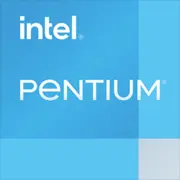Intel Pentium 3825U

Intel Pentium 3825U:日常作業向けの低価格プロセッサ
2025年の機能と実用性の分析
アーキテクチャとプロセス技術:Broadwellの基盤
2015年に発売されたIntel Pentium 3825Uは、Broadwell(第5世代Intel Core)マイクロアーキテクチャに基づき、14nmプロセスで製造されています。これは、14nm技術が実装されたIntelの最初のチップの一つであり、性能を大きく損なうことなく消費電力を削減することを可能にしました。
主な仕様:
- コアとスレッド: 2コア、4スレッド(Hyper-Threadingにより)。
- クロック周波数: 基本1.9GHz、ターボモードで最大2.5GHz。
- キャッシュ: L3は2MBで、当時としては控えめですが、軽作業には十分です。
- iGPU: Intel HD Graphics(Broadwell GT1)は、12の実行ユニット(EU)を搭載し、最大850MHzで動作します。DirectX 11.2と4K@60Hz(DisplayPort経由)をサポート。
アーキテクチャの特徴:
- 電力効率: 14nmプロセスとTDP 15Wにより、ウルトラブックに最適です。
- 古い技術: AVX2や最新のAI命令(例:DL Boost)をサポートしておらず、機械学習のタスクに制約があります。
エネルギー消費とTDP:パフォーマンスとバッテリー寿命のバランス
TDP 15Wは、プロセッサが受動的または低出力のアクティブ冷却を想定していることを意味します。これにより:
- 利点: このCPUを搭載したノートパソコンは薄型(厚さ18mmまで)で軽量(1.2〜1.5kg)です。
- 欠点: 長時間の負荷(例えば、ビデオレンダリング)がかかると、熱によるサーマルスロットリングが発生し、周波数が低下する可能性があります。
省エネ技術:
- Intel SpeedStep: 負荷に応じて動的に周波数を調整します。
- Cステート: 未使用のコアをオフにしてバッテリーを節約します。
パフォーマンス:2025年にPentium 3825Uは何ができるか?
Geekbench 6による評価:
- シングルコア:296 — Intel Core i3-5005U(2015年)に匹敵。
- マルチコア:580 — 予算向けAMD Ryzen 3 5300U(2020年)には劣り、同モデルは約1200ポイントを獲得。
実際のシナリオ:
1. オフィス作業:
- Googleドキュメント、Excel、10以上のタブを持つブラウザ — 快適ですが、Zoomを同時に起動すると遅延が発生する可能性があります。
- 提案:バックグラウンドアプリを閉じること。
2. メディア処理:
- 4Kビデオの再生(YouTubeまたはローカルファイル経由) — ハードウェアデコードを使用すればスムーズに再生。
- Lightroomでの写真編集 — 遅いが、基本的な修正には可能。
3. ゲーム:
- 古いゲーム:Minecraft(低設定で30〜40FPS)、CS:GO(25〜30FPS)。
- クラウドゲーミング(GeForce NOW、Xbox Cloud) — 現代のプロジェクトに最適。
ターボブーストモード:
- 一時的に2.5GHzまで増加することが「かかりやすい」負荷(例えば、重いPDFファイルを開く)には役立ちますが、長時間の作業(ビデオ変換など)には効果的ではありません。
使用シナリオ:どのような人にこのプロセッサが向いているか?
- 学生: 学業用(文章作成、プレゼンテーション、オンラインコース)。
- オフィス職員: 文書やメールの作成。
- 「サーフィン」ユーザー: ソーシャルメディア、音楽・ビデオのストリーミング。
- 向かない人: ゲーマー、ビデオ編集者、エンジニア(CAD、3Dモデリング)。
バッテリー寿命:ノートパソコンはどれくらい持つか?
Pentium 3825Uを搭載したデバイスの平均稼働時間は 6〜8時間 で、以下の状態で:
- 画面輝度150nit。
- ブラウザとオフィスアプリの積極的な使用。
バッテリー持ちを短くする要因:
- Chromeを20以上のタブで開く。
- 外付けデバイス(HDD、USBデバイス)の接続。
提案: 45W・h以上のバッテリーを持つノートパソコン(例:Acer Aspire 5)を選ぶと、2〜3年の使用後でもバッテリーが持ちます。
競合他社との比較
1. AMD A6-9220(2017年):
- 利点:グラフィックス性能が優れ(Radeon R4)。
- 欠点:消費電力が高く(TDP 15Wだが、実際には25Wまで)、バッテリーの減りが早い。
2. Intel Celeron N5100(2021年):
- 利点:AVX2をサポート、最新の10nmプロセス。
- 欠点:価格が高め(ノートパソコンは$350から)。
3. Apple M1(2020年):
- パフォーマンスとバッテリー寿命で群を抜いているが、価格は$999から。
結論: Pentium 3825Uは、300ドル以下の予算セグメントでのみ有効であり、中古デバイスまたはChromebookが代替手段となります。
長所と短所
強み:
- ノートパソコンが安価(新しいモデルは250ドル〜350ドル)。
- 基本的な作業に対する十分なパフォーマンス。
- コンパクトで静かな動作(モデルによってはファンなし)。
弱み:
- 古いアーキテクチャ:2020年代の予算プロセッサにも後れを取る。
- 限られたマルチタスク性能:複数の重いアプリを同時に起動すると「フリーズ」することがあります。
- 弱いグラフィックス:快適なゲーミングが不可能。
ノートパソコン選びの推奨事項
1. デバイスタイプ:
- ウルトラブック: 例えば、Lenovo IdeaPad Slim 3 — 重さ1.4kg、持ち運びやすい。
- 予算ノートパソコン: HP 15-dw2000 — 15.6インチ画面、HDD+SSDスロット。
2. 注目すべき点:
- RAM: 最低8GB(DDR3L)。
- ストレージ: SSD必須(128GBでもシステム用として十分)。
- ディスプレイ: 解像度1920×1080のIPSパネル。
3. 避けるべきこと:
- SSDの代わりにHDDを搭載したバージョン。
- Wi-Fi 5(802.11ac)をサポートしないモデル。
最終結論:Pentium 3825Uは誰に向いているか?
このプロセッサは、次のような人々に最適です:
- 基本的な作業用に価格が可能な限り安い新しいノートパソコンを探している人。
- 「重い」プログラムやゲームを実行するつもりがない人。
- バッテリー寿命とポータビリティを重視する人。
主な利点:
- 価格は350ドル未満。
- 日常業務の80%に対して十分なパフォーマンス。
- アップグレードが可能(SSDやRAMの追加)。
代替案: 予算が400〜500ドル可能であれば、Intel Core i3-1215UまたはAMD Ryzen 3 7320Uを搭載したノートパソコンを選ぶと、より長持ちし、パフォーマンスに失望することがありません。
この記事は2025年4月の情報に基づいています。価格は米国における新しいデバイスのものです。
基本
CPUの仕様
メモリ仕様
GPUの仕様
その他
ベンチマーク
他のCPUとの比較
ソーシャルメディアで共有する
または当サイトへのリンクを追加
<a href="https://cputronic.com/ja/cpu/intel-pentium-3825u" target="_blank">Intel Pentium 3825U</a>